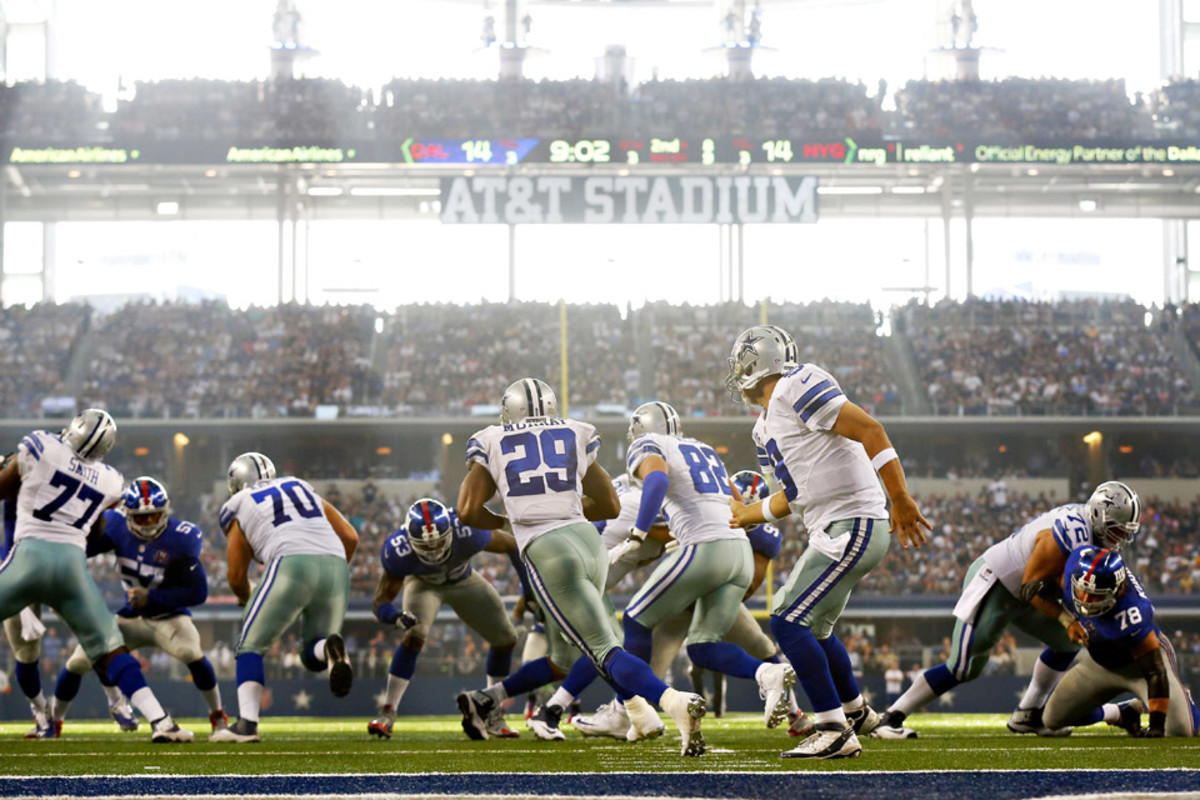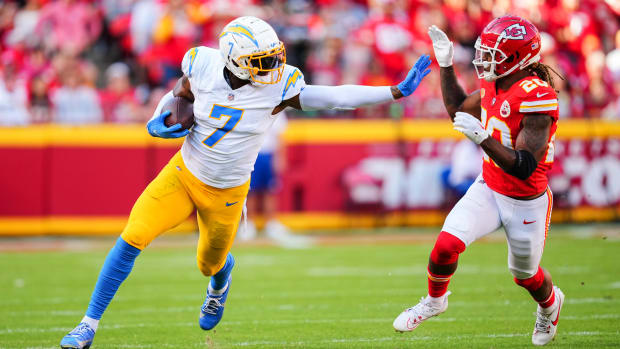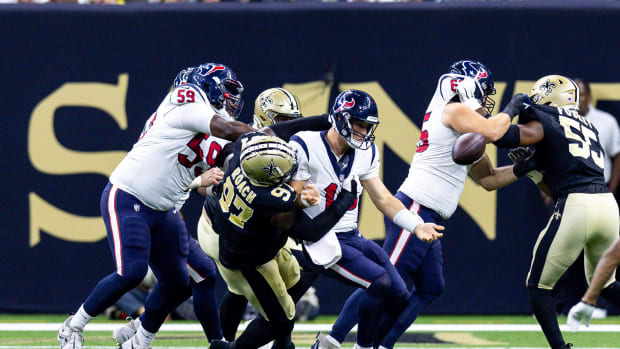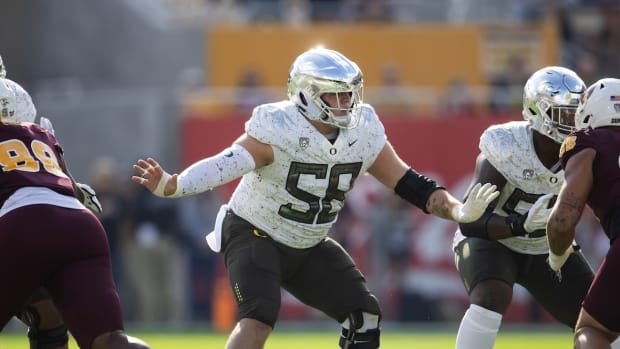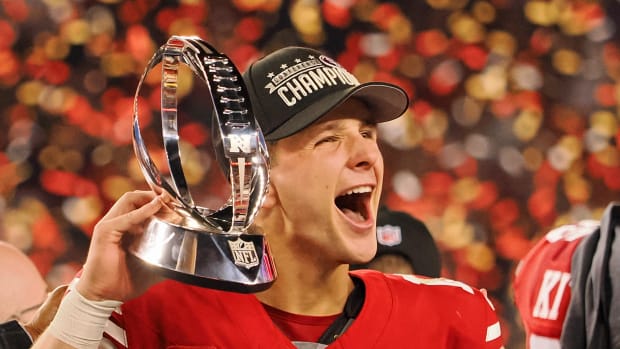On A Run and Loving It
We all know the NFL has a tendency to tinker a little too much with its rules, but halfway through this 2014 season, I’m really liking some of the league’s new innovations. Especially that big, bold change on offense. The one that really seems to be working and has made everything about football that much more compelling to watch.
What do they call it again, a “running game”? What will they think of next!
If you like a little balance on offense, the NFL has been positively old school in 2014. Led by those first-place Cowboys, the NFL has gone to ground. And count me among those who think it’s a better, more well-rounded game for it.
Nowhere is the back to the future approach more vividly on display than in Dallas, where the surprising Cowboys are 6-2, running for a league-best 160.5 yards per game—66.5 more than last season—and turning the beast known as DeMarco Murray loose on a weekly basis.
In a supposedly pass-crazy league, Murray already shattered one hallowed Jim Brown record (eight consecutive 100-yard rushing games to start the season) and with 1,054 yards through eight games he’s on pace to break Eric Dickerson’s 30-year-old single-season rushing mark of 2,105 yards. If this keeps up, Troy Aikman is going to feel like he fell asleep and woke up in the early ’90s, except Emmitt Smith’s noticeably taller, switched uniform numbers, and everyone keeps calling him “DeMarco’’ for some reason.
“I’m not surprised by the success of the teams we’ve seen being able to run the ball a little bit more,’’ said Aikman, the Hall of Fame Dallas quarterback and current FOX analyst. “These Cowboys, they remind me an awful lot of how we did it when we were winning Super Bowls. And it’s made a huge difference for them, and helped out their defense and brought some toughness to that defense.
The Real Stars in Dallas
Credit the Cowboys’ coaching staff for getting the most out of their roster and turning the team into the season’s biggest surprise. But will it last? FULL STORY
“There does seem to be more of a commitment by more teams to run the ball, and maybe that’s because of the success we’ve seen some recent teams have. It’s still a copy-cat league, and when Seattle wins a Super Bowl, everyone starts looking at the things they’re doing. They were one of the few teams to have a really dominant defense, but they also run the ball. So I do think we’ve kind of hit a point where, ‘Okay, we’ve swung the whole way toward all the throwing and now it seems to be swinging back the other way.’”
No one, Aikman included, is suggesting the pendulum is going to go all the way and render the pass passé. We’re not ever going back to the ’70s and the Bob Griese-Terry Bradshaw-style model of 12 to 15 passes a game, not after the 1978 rule changes that basically made pass defense a hands-off experience. The zealots that infuse the Fantasy Football world would riot in the streets, and NFL league office types and TV network executives would be right there alongside them, promoting more passing. But Aikman’s on to something here, because there have been too many recent examples of teams running to success to disregard as statistical noise.
Last season, only two teams ran the ball more than they threw it: Seattle (52.3% running plays) and San Francisco (52.5%). They went a combined 30-8 (including the playoffs) and met in the NFC Championship game. Of the top seven teams in rushing play percentage, five of them went to the playoffs, with Carolina (48.3%), Philadelphia (47.4%) and San Diego (45.8%) ranking fourth, sixth and seventh in that department.
Casting an even wider net, nine of the 12 NFL teams that made the playoffs in 2013 ranked in the top half of the league in rushing play percentage, striking a blow for balance by running at least 41 percent of the time. In 2012, nine of the top 16 teams in rushing play percentage went to the postseason by running 42 percent or more of the time, including the top three of Seattle, Washington and San Francisco. That season, Super Bowl champion Baltimore finished 11th in the league in rushing yards per game (118.8) and came on strong in the ground game during a decisive December-January hot streak.
And hey, let’s not forget, that record-breaking Peyton Manning-led Broncos passing game has hung up what Jim Irsay likes to call “Star Wars numbers’’ the past two seasons, but all Manning all the time hasn’t produced a Super Bowl ring in the Rockies, now has it? So maybe the ground did start to shift beneath our feet a couple years ago—back toward the running game—but the movement was so subtle that we didn’t detect it.
Midseason All-Pro Team
Four Cowboys made the cut as The MMQB's Andy Benoit chooses the best of the best at each position. FULL STORY
“That blueprint of riding a running game to success was on display last year with Seattle and San Francisco,” Aikman said. “And it’s been a good formula for a long time. With the new rules on defense, things went to the extreme toward the passing game, and moved heavily in that direction. But some winning teams are going back to a little of that old-school formula, and Dallas is kind of leading that charge this year.’’
Fourteen teams have a higher rushing play percentage this year at midseason than they did for all of 2013, with clubs like Dallas (35.1% in 2013 to 49.5% this year), Houston (38.0% to 50.9%) and Cleveland (32.3% to 49.0%) taking it to extremes, increasing their run frequency by double-digit margins. Not coincidentally all three teams are either in first place in their division, or no more than one game out of the lead.
Led by Murray’s breakthrough performance, the league’s top four rushers all play on teams that are .500 or better: Murray’s Cowboys at 6-2, Arian Foster (766 yards) and the Texans at 4-4, Le’Veon Bell (691) and the Steelers at 5-3, and Justin Forsett (571) and the Ravens at 5-3. That's a combined record of 20-12, which falls roughly in line with the correlation for NFL success that existed in 2013. Teams with a 100-yard rusher in a game went 60-33-2 (.642), higher than that of a 100-yard receiver (98-82, .544) or a 300-yard passer (60-58, .508).
Week 8 was an especially productive one for rushing attacks. The Saints’ Mark Ingram churned out career bests in carries (24) and yards (172) in a win over Green Bay. It was the biggest game for a Saints rusher in almost 11 years, and proved that New Orleans isn’t just Drew Brees and a pyrotechnic passing game. Foster clicked for 151 yards in his fourth consecutive 100-yard game (and sixth overall) in a win at Tennessee. And Murray added another 141 yards to his gaudy total (on just 19 carries, a 7.4-yard average)—alas the Cowboys lost to Washington on Monday Night Football, snapping a six-game Dallas winning streak.
DeMarco's Costly Run
DeMarco Murray is off to a historically great start in a contract year. The problem, says Andrew Brandt: Every yard he gains could be costing him the big payday he’s trying to earn. FULL STORY
With 206 carries at midseason, Murray is on a pace for 412. That would be the second-most ever in a season, and overuse is a concern. But it’s an easier case to make that the Cowboys should have kept handing him the rock against Washington, given that he averaged 9.6 yards ever time he touched it (he also added four receptions for 80 yard, giving him 23 touches for 221 yards on the night).
With the health of Tony Romo’s back again an issue, now’s the time to ride Murray more than ever. No Stephen Strasburg pitch count need apply. That’s not the way Emmitt and his Cowboys would have done it.
“I know that Jason [Garrett], being a part of some of our Super Bowl teams, has said the running game is the blueprint for success, and now finally he’s put that blueprint in,’’ Aikman said. “Dallas actually ran the ball successfully last year, and they were (tied for seventh) in yards per carry in the league (4.5). So when they ran it, they ran it well. But it’s a commitment within the entire organization, and that commitment has paid off. And I think we’re seeing some of that same thinking spreading around the league in other places, too.”
That’s a very good development for those of us who think football is at its best when there’s a mixture of moving the ball on the ground and through the air, bringing variety and more than a best-quarterback-wins element to the league’s weekly competition. So welcome back, NFL running games. I for one have missed you. Let’s hope the trend back toward rushing the ball is not merely a passing phase.
[widget widget_name="SI Newsletter Widget”]
































